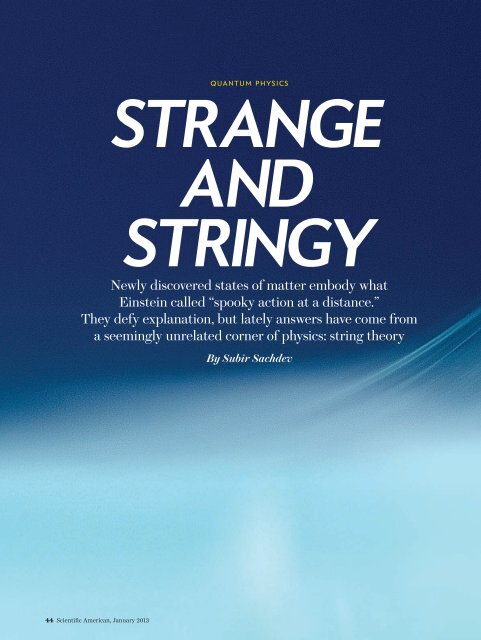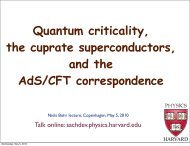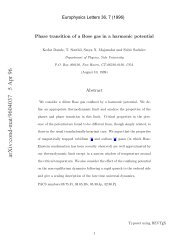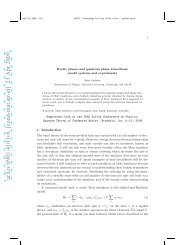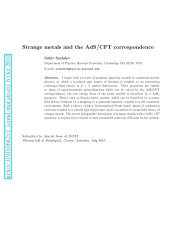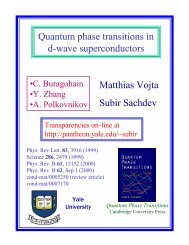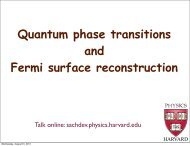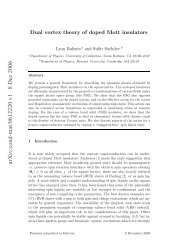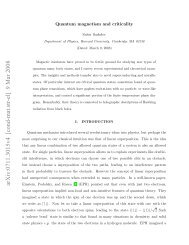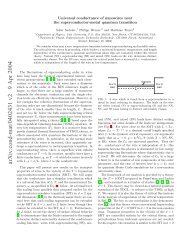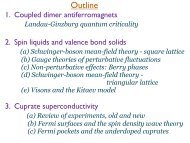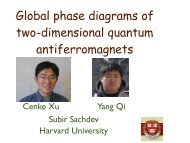Strange and Stringy - Harvard University
Strange and Stringy - Harvard University
Strange and Stringy - Harvard University
- No tags were found...
Create successful ePaper yourself
Turn your PDF publications into a flip-book with our unique Google optimized e-Paper software.
quantum physics<strong>Strange</strong><strong>and</strong><strong>Stringy</strong>Newly discovered states of matter embody whatEinstein called “spooky action at a distance.”They defy explanation, but lately answers have come froma seemingly unrelated corner of physics: string theoryBy Subir Sachdev44 Scientific American, January 2013Photograph by Tktk Tktk
MAGNET is being levitated by anunseen superconductor in whichcountless trillions of electronsform a vast inter connected quantumstate. Astoundingly, thequantum state of many modernmaterials is subtly related to themathematics of black holes.Illustration by Artist NameJanuary 2013, ScientificAmerican.com Photograph by Zachary Zavislak 45
Subir Sachdev is a professor of physics at<strong>Harvard</strong> <strong>University</strong> <strong>and</strong> author of the bookQuantum Phase Transitions, now in a secondedition (Cambridge <strong>University</strong> Press, 2011).SEVERAL YEARS AGO I FOUND MYSELF WHERE I WOULDnever have expected: at a conference of stringThis difference in subject matter is mirrored by a culturalgap. String theorists have a formidable reputation, <strong>and</strong> I wentto the meeting in awe of their mathematical prowess. I hadspent several months reading their papers <strong>and</strong> books, <strong>and</strong> I oftengot bogged down. I was certain I would be dismissed as anignorant newcomer. For their part, string theorists had difficultywith some of the simplest concepts of my subject. I foundmyself drawing explanatory pictures that I had only ever usedbefore with beginning graduate students.So what was I doing there? In recent years many of us whospecialize in condensed matter have discovered our materialsdoing things we never thought they could. They form distinctivelyquantum phases of matter, the structure of which involvessome of the weirdest features of nature. In a famous paperin 1935 Albert Einstein, Boris Podolsky <strong>and</strong> Nathan Rosendrew attention to the fact that quantumtheory implied a “spooky” connection betweenparticles such as electrons—what wenow call quantum entanglement. Somehowthe activities of the particles are coordinatedwithout mediation by a direct physicallinkage. EPR (as Einstein <strong>and</strong> his co-authorsare widely known) considered pairsof electrons, but metals <strong>and</strong> superconductorsinvolve vast numbers of electrons—some 10 23 of them, for a typical sample ofmaterial in the lab. In some materials, the complexity is mindboggling,<strong>and</strong> I have spent much of my career trying to wrapmy head around it. The problem is not merely academic: superconductorshave become important technologically, <strong>and</strong>physicists have struggled to make sense of their properties <strong>and</strong>capabilities.Then my colleagues <strong>and</strong> I came to realize that string theorycould offer a completely unforeseen approach to such problems.In seeking to unify the theory of elementary particleswith Einstein’s theory of gravitation, string theorists had stumbledacross “dualities”—hidden connections between far-flungareas of physics [see “The Illusion of Gravity,” by Juan Maldacena;SCIENTIFIC AMERICAN, November 2005]. The dualities relate theoriesthat work where quantum effects are weak but gravity isstrong to theories that work where quantum effects are strongIN BRIEFMatter can assume many forms other than solid, liquid<strong>and</strong> gas. The electrons that perfuse materials can undergotheir own transitions, which involve inherentlyquantum properties of matter. Superconductors are thebest-known example.These states of matter arise from an unimaginablycomplex web of quantum entanglement among theelectrons—so complex that theorists studying thesematerials have been at a loss to describe them.Some answers have come from an entirely separateline of study, string theory, typically the domain of cosmologists<strong>and</strong> high-energy particle theorists. On theface of it, string theory has nothing to say about the behaviorof materials—no more than an atomic physicistcan explain human society. And yet connections exist.46 Scientific American, January 2013
ut gravity is weak. So they let us take insights from one realm<strong>and</strong> apply them to the other. We can translate our entanglementproblem into a gravitational problem <strong>and</strong> avail ourselvesof the efforts that string theorists have put into underst<strong>and</strong>ingblack holes. It is lateral thinking at its finest.Hidden PHasesTO UNDERSTAND this circle of ideas, step back to high schoolphysics, where teachers spoke of the phases of matter in termsof solids, liquids, gases. We have an intuitive grasp of the distinctionsamong these phases. Solids have a fixed size <strong>and</strong>shape; liquids take the shape of their container; <strong>and</strong> gases arelike liquids, but their volume can be changed easily. Simple asthese distinctions are, it was not until the early 20th centurythat a complete scientific underst<strong>and</strong>ing of the phases of matteraround us emerged. Atoms have a regular, rigid arrangementin crystalline solids but are mobile in liquids <strong>and</strong> gases.Yet these three phases do not begin to exhaust the possibilities.A solid is not just an array of atoms but also a swarm ofelectrons. Each atom offers up a few electrons, which roamacross the entire crystal. When we connect a specimen to a battery,an electric current flows. Essentially all materials satisfyOhm’s law: the current is proportional to the voltage divided bythe resistance. Electrical insulators such as Teflon have a highresistance; metals such as copper, a low resistance. Most remarkableare the superconductors, which have an immeasurablysmall resistance. In 1911 Heike Kamerlingh Onnes discoveredthem when he cooled solid mercury below –269 degreesCelsius. Today we know of superconductors that work at a comparativelybalmy –138 degrees C.Although it is not obvious just by looking at them, conductors,insulators <strong>and</strong> superconductors are different phases ofmatter. In each, the swarm of electrons takes on a differentform. Over the past two decades physicists have discovered additionalphases of electrons in solids. A particularly interestingexample does not even have a proper name: physicists have defaultedinto calling it the strange metal. It betrays itself by theunusual way its electrical resistance depends on temperature.The differences among these phases arise from the collectivebehavior of electrons. Whereas the motion of atoms in solids,liquids <strong>and</strong> gases can be described by the classical principlesof Newtonian mechanics, the behavior of electrons isineluctably quantum. The key quantum principles governingthe electrons are scaled-up versions of those governing theelectrons in an atom. An electron orbits the nucleus, <strong>and</strong> itsmotion is described as a wave that propagates around the proton.The electron can reside in an infinite number of possiblestates with specific observable properties such as energy. Crucially,the electron not only orbits the nucleus but also spinsaround its own axis. This spin can be either clockwise or anticlockwise<strong>and</strong> cannot be slowed down or sped up; we conventionallylabel these two spin states as “up” <strong>and</strong> “down.”In atoms with more than one electron, the most importantrule governing the electrons is the Pauli exclusion principle: notwo electrons can occupy the same one-electron state. (Thisprinciple applies to all particles of matter, which physicists callfermions.) If you add electrons to an atom, each new electronsettles into the lowest-energy state it can, like filling a glasswith water from the bottom up.The same reasoning also applies to the 10 23 electrons in apiece of metal. The itinerant electrons, once detached fromtheir original host atoms, occupy states that extend across theentire crystal. These states can be thought of as sinusoidalwaves with a certain wavelength that is related to their energy.Electrons occupy states with the lowest-allowed energy that isconsistent with the exclusion principle. Together they typicallyfill all the states up to an energy smaller than a thresholdknown as the Fermi energy.Applying a voltage gives some electrons enough energy totransfer from an occupied state to a previously unoccupied onewith an energy larger than the Fermi energy [see box on nextpage]. That electron can then flow freely. In an insulator, thedensity of electrons results in all accessible states being occupiedalready; even if we apply a voltage, there is no place for anelectron to go, so no current can flow.In superconductors, things get more complicated. The electronsin them cannot be understood one at a time. They bindinto pairs, as described by the theory of superconductivity developedin 1957 by theoretical physicists John Bardeen, LeonCooper <strong>and</strong> John Robert Schrieffer (also referred to as BCS). Onthe face of it, the particulate buddy system is odd because twoelectrons should repel each other. Vibrations of the crystal lattice,however, indirectly create an attractive force that overcomesthe innate repulsion. Each pair behaves not as a fermionbut as a different type of quantum particle known as a boson,which does not obey the Pauli exclusion principle. The electronpairs can all condense into the same state having the barestminimum amount of energy—a phenomenon known as Bose-Einstein condensation. It is like pouring water into a glass <strong>and</strong>,instead of filling up the glass, forming a thin layer of ice acrossthe bottom that can absorb as much water as you care to addwithout getting thicker.If you apply a voltage across such a material, that voltagepushes the electron pairs into a state with ever so slightly higherenergy, yielding an electric current. This higher-energy stateis otherwise empty, leaving nothing to impede the flow of thepaired electrons. In this way, a superconductor transmits currentwith zero resistance.GoinG CritiCalTHESE SUCCESSES of quantum theory in explaining metals, insulators,superconductors <strong>and</strong> other materials such as semiconductors(the basis of modern electronics) led many physicistsin the early 1980s to conclude that they were approaching a fullunderst<strong>and</strong>ing of electrons in solids, with no remaining majordiscoveries to be made. This confidence was spoiled by the discoveryof high-temperature superconductors.An example is barium iron arsenide, in which experimentalistshave replaced some fraction of the arsenic with phosphorus.At low temperatures, this material is a superconductor,<strong>and</strong> physicists believe it obeys a theory similar to that of BCSexcept that the attractive force between electrons does not originatefrom vibrations of the crystal lattice but from physics associatedwith the electron spin. With a small amount of phosphorus,the material forms a state known as a spin–densitywave [see “Charge <strong>and</strong> Spin-Density Waves,” by Stuart Brown<strong>and</strong> George Grüner; SCIENTIFIC AMERICAN, April 1994]. On halfof the iron sites, the electron spin is more likely to be up thanJanuary 2013, ScientificAmerican.com 47
STATES OF MATTERJust a Phase They’re Going ThroughQuantum physics gives the building blocks of matter radically new ways to organize themselves. The classical solid, liquid <strong>and</strong> gaseous phasesthat particles exert on one another <strong>and</strong> hence the way they assemble.Classical Phases see phase diagram on opposite pageSolid Liquid GasQuantum Phases not shownsee phase diagram on opposite pageConductor (metal) Insulator Superconductor48 Scientific American, January 2013Illustrations by George Retseck
PressureDistance between AtomsSolidSpin-density waveLiquid<strong>and</strong> gasbecomeindistinguishableQuantumcriticalpointSuperconductorTemperatureMetalTemperatureLiquidGasCriticalpointMetal grades into strange metaldown, <strong>and</strong> vice versa on the other half. As you increase theamount of phosphorus, the strength of the spin-density wavediminishes. It disappears altogether when you have replaced acritical amount of arsenic, about 30 percent. At that point, theelectron spin is equally likely to be up or down on each site,which has important consequences.The first indication of the mysterious nature of this quantumcritical state is the behavior of the system as experimentalistshold the amount of phosphorus fixed at 30 percent <strong>and</strong>raise the temperature. The result is neither a superconductornor a spin-density wave but a strange metal.The main new idea needed to describe the quantum-criticalpoint, <strong>and</strong> the superconductors <strong>and</strong> strange metals close to it,is precisely the feature of quantum mechanics that so disturbedEinstein, Podolsky <strong>and</strong> Rosen: entanglement. Recall that entanglementis the superposition of two states—such as whenone electron is spinning up <strong>and</strong> the other down, <strong>and</strong> vice versa.Imagine single electrons at two iron sites. Electrons are indistinguishableeven in principle, so it is impossible to say whichelectron is up <strong>and</strong> which is down; both are equally likely to beup or down. All we can say is that if we measure one electron asup, the other is guaranteed to be down. They are perfectly anticorrelated:if we know one, we know the other.At first glance, entanglement might not seem strange. Anticorrelationis common: if you have a pair of shoes <strong>and</strong> you putone in the front hallway <strong>and</strong> the other by the back door, then ifyou find a left shoe in one place, it is no mystery that the othershoe is right. Yet the quantum situation differs in an essentialway. A shoe is either left or right even if you do not know whichit is, but an electron has no fixed spin until the act of measurement.(If it did, we could tell by conducting a certain sequencesof measurements on it.) In a sense, the electron is both up <strong>and</strong>down until forced to choose.The mystery is how the electrons remain anticorrelated.When one electron chooses its spin, so does the other. How dothey know to choose opposite directions? It seems that informationon the quantum state of atom 1 is instantaneouslyknown to atom 2, no matter how far away it is. Indeed, neitheratom has a quantum state on its own; only the pair of themdoes. That is the nonlocality, the spooky action at a distance,that Einstein found so unpalatable.Unpalatable or not, nonlocality has been verified numeroustimes in actual experiments. Einstein <strong>and</strong> his co-authors clearlyput their finger on the most counterintuitive <strong>and</strong> unexpectedaspect of quantum mechanics. And in the past decade physicistsare beginning to appreciate that it accounts for the bizarreproperties of strange metals. Close to the quantum-criticalpoint, the electrons no longer behave independently or even inpairs but become entangled en masse. The same reasoning thatEPR applied to two electrons now applies to all 10 23 of them.Neighboring electrons are entangled with each other; this pair,in turn, is entangled with neighboring pairs, <strong>and</strong> so on, creatingan enormous network of interconnections.The same phenomenon occurs in other materials as well.Classifying <strong>and</strong> describing such entangled states is the forbiddingchallenge we face in developing the theory that describesthe new materials. The network is so complex that it is beyondour ability to describe directly.My colleagues <strong>and</strong> I used to worry that a theory of theseJanuary 2013, ScientificAmerican.com 49
quantum phases of matter would forever elude us. That was beforewe learned about string theory.CONNECTION TO STRING THEORYWeb of EntanglementFor reasons that physicists have yet to underst<strong>and</strong>, quantum phasesof matter contain a latent spatial dimension that can appear atElectronEntangled electronsElectron EntanglementEntanglement means that multiple quantum particles act together as a singleindivisible whole. Typically physicists talk about the entanglement of two particlesor perhaps a h<strong>and</strong>ful of them, but in materials that transition from one quantumphase to another, huge numbers of electrons are entangled.Tangled Up in STringSON THE FACE OF IT, string theory has nothing to do with entangledstates of many electrons. It involves microscopic stringsthat vibrate like miniature guitar strings; the different modesof vibrations represent different elementary particles. Thestringy nature of matter becomes evident at extremely high energies,found only moments after the big bang <strong>and</strong> near verydense black holes. In the mid-1990s string theorists such as JosephPolchinski of the Kavli Institute for Theoretical Physics atthe <strong>University</strong> of California, Santa Barbara, realized that theirtheory predicts more than strings. It also implies the existenceof “branes”: surfaces to which strings stick like bugs on flypaper.These membranes represent a vast kingdom of physics, beyondthe high-energy particles the theory originally addressed.What looks like a particle—a mere point—to us might actuallybe the end point of a string stretching from a brane througha higher spatial dimension. We can view the universe either asmade up of point particles moving in a four-dimensional spacetimewith a complex set of interparticle interactions or as madeup of strings moving in a five-dimensional spacetime attachedto branes. These two perspectives are equivalent, or dual, descriptionsof the same situation. Remarkably, these two descriptionsare complementary. When the point particles arehopelessly complex, the strings may behave simply. Conversely,when the particles are simple, the strings are clumsy <strong>and</strong>cumbersome.For my purposes, the picture of strings dancing in somehigher-dimensional spacetime is not important. It does noteven matter to me whether string theory is a correct explanationof particle physics at very high energies. What is significantis that the duality lets me exchange a mathematically intractableproblem for an easy one.Until a few years ago, I mainly attended meetings of condensed-matterphysicists in which we argued about the differententangled quantum states that electrons could form innewly discovered crystals. Now I find myself sipping coffeewith string theorists, trying to make sense of their abstract <strong>and</strong>fanciful description of strings <strong>and</strong> branes <strong>and</strong> applying thoseideas to down-to-earth issues raised by tabletop measurementson the new materials. Moreover, it is a two-way street. I thinkthat our intuition <strong>and</strong> experimental experience with the quantumphases of electrons is helping string theorists to describeblack holes <strong>and</strong> other exotica.When electrons in crystals have only a limited degree of entanglement,they can still be thought of as particles (either theoriginal electrons or pairs of them). When large numbers ofelectrons become strongly entangled with one another, however,they can no longer be viewed as particles, <strong>and</strong> conventionaltheory struggles to predict what happens. In our new approach,we describe these systems in terms of strings that propagate inan extra dimension of space.My <strong>Harvard</strong> <strong>University</strong> colleague Brian Swingle has drawn ananalogy between the extra spatial dimension <strong>and</strong> the network ofquantum entanglement [see box above]. Moving up <strong>and</strong> downthe network is mathematically just like moving through space.The strings can wriggle <strong>and</strong> fuse together within the extra dimension,<strong>and</strong> their motion mirrors the evolving entanglement ofparticles. In short, the spooky connections that troubled Einsteinmake sense when you think of the degree of entanglement as distancethrough an extra spatial dimension.STrange CoUSinSTHE PRACTICAL ADVANTAGE of these dualities is that string theoristshave built up a large library of mathematical solutions toproblems ranging from particle dynamics in the furnace of thebig bang to the undulations of quantum fields on the lip ofblack holes. Those of us studying quantum phases of mattercan go to the library, look up a possible solution to a specificproblem <strong>and</strong> translate it (using the mathematics of duality)from the stringy situation to the entanglement situation.Typically we focus on the lowest-energy state at absolutezero, but we can readily describe matter at nonzero temperaturesusing a technique that might seem drastic: we imagineadding a black hole to the string situation. The fact that blackholes are involved indicates how extraordinary these dualitiesare. No one is suggesting that the quantum phases of matter literallycontain black holes; the connection is more subtle. StephenHawking of the <strong>University</strong> of Cambridge famously showed thatevery black hole has a certain temperature associated with it.From the outside, a black hole looks like a glowing hot coal. Bythe logic of duality, the corresponding condensed-matter systemmust also be hot, which has the effect of turning a spindensitywave or a superconductor into a strange metal.These methods have made some progress in explaining50 Scientific American, January 2013
Depth of EntanglementSpaceHierarchy of Entanglementdistance. Much as moving through space entails passing through interveningpoints, getting from the entanglement of two particles up to trillions requires thetwo to combine with two others, <strong>and</strong> the resulting four with four more, <strong>and</strong> so on.Extra Spatial DimensionThus, the depth of entanglement itself acts as an implicit spatial dimension,above <strong>and</strong> beyond the three dimensions where the electrons reside. By using thismathematical resemblance, theorists studying quantum phases of matter canstrange metals <strong>and</strong> other states of matter, but they have helpedthe most with the transition from a superfluid to an insulator.A superfluid is just like a superconductor, except it is made upof electrically neutral atoms; it reveals itself not by having zeroelectrical resistance but by flowing without any friction. In recentyears experimentalists have developed remarkable newmethods of creating artificial superfluids. They create a latticeof crisscrossing lasers <strong>and</strong> pour in trillions of extremely cold atoms.The atoms initially behave like a superfluid: they movefreely from one lattice site to another. As experimentalists dialup the intensity of the laser, the atoms become less mobile <strong>and</strong>the superfluid abruptly turns into an insulator.Experimentalists follow this transition by measuring howthe atoms flow under external pressure. In the superfluid phase,they flow without resistance; in the insulator phase, they hardlyflow at all; <strong>and</strong> at the transition, they flow but in a peculiar way.For instance, if experimentalists remove the external disturbance,the atoms come to a halt at a rate that depends on thetemperature <strong>and</strong> on Planck’s constant, the fundamental parameterof quantum theory, which does not enter into the behaviorof the other phases. We have explained this behavior by imaginingthe quantum-critical fluid as the dual, or stringy doppelgänger,of a black hole.The duality has a downside. By its very nature, it transformsthe complex to the simple. We do not always want to transformthe problem, however: we also want to underst<strong>and</strong> the complexityfor what it is. The duality is a mathematical black box<strong>and</strong> leaves us somewhat in the dark about the details of thecomplicated entangled states or about how these states occurin actual materials. Explaining what is really going on is still inits infancy. For those of us accustomed to thinking about thedynamics of electrons in crystals, string theory has given afresh new perspective on the dynamics of complex quantumstates involving entanglement. For string theorists, it haspiqued interest in the phases of quantum materials, phenomenafar removed from the physics of the early universe or thatoccurring in high-energy particle accelerators. The strangeconfluence of these currents of thought has shown us the wonderfulunity of nature.more to exploreSolving Quantum Field Theories via Curved Spacetimes. Igor r. Klebanov <strong>and</strong> Juan m.maldacena in Physics Today, Vol. 62, No. 1, pages 28–33; January 2009. http://dx.doi.org/10.1063/1.3074260Entanglement Renormalization <strong>and</strong> Holography. Brian Swingle. Submitted to arxiv.orgon may 8, 2009. http://arxiv.org/abs/0905.1317What Black Holes Teach about Strongly Coupled Particles. peter Steinberg in Physics Today, Vol. 63, No. 5, pages 29–33; may 2010. http://dx.doi.org/10.1063/1.3431328Quantum Criticality. Physics Today, Vol. 64, No. 2,pages 29–35; February 2011. http://arxiv.org/abs/1102.4628What Can Gauge-Gravity Duality Teach Us about Condensed Matter Physics? SubirAnnual Review of Condensed Matter Physics, http://arxiv.org/abs/1108.1197Scientific AmericAn Onlineto see a video explaining entanglement, visit entanglementJanuary 2013, ScientificAmerican.com 51


